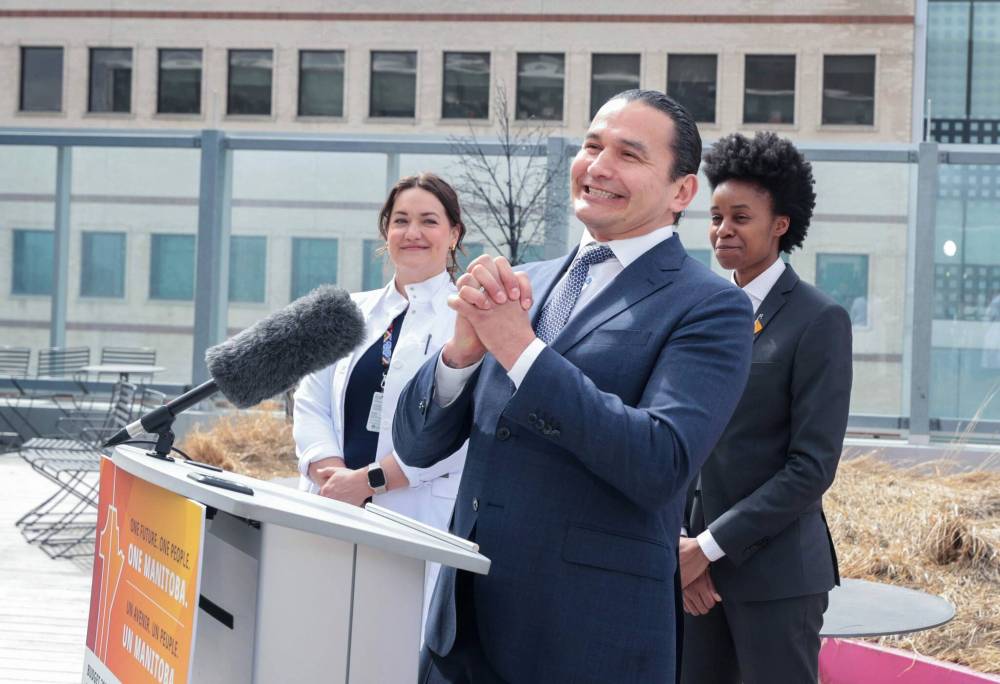By any measurement, it was a good news announcement.
On Monday, the new NDP government announced it was funding 50 new beds for the Health Sciences Centre as part of a $65-million commitment to expand hospital capacity across the province to ease overcrowding in emergency rooms and shorten wait lists for surgical and diagnostic procedures.
And yet, as positive as this announcement was, you could forgive HSC officials for perhaps harbouring a bigger, lingering question: what about the $1.5-billion expansion?

RUTH BONNEVILLE / FREE PRESS
Premier Wab Kinew and the NDP announced funding for 50 new beds at the Health Sciences Centre Monday.
Just before the 2023 fall election, then-premier Heather Stefanson promised an ambitious, $1.5-billion capital investment at HSC that included the purchase and repurposing of the half-empty Manitoba Clinic building, and a new adult medicine tower with 240 private hospital rooms.
The NDP was largely silent on Stefanson’s plan for HSC during the election. Now in power, Premier Wab Kinew’s government remains just as silent about the future of what Stefanson’s Tories called the largest health-care capital investment in Manitoba history.
Does the project still have life?
Officials with the NDP government would say only they are committed to the HSC expansion but have yet to figure out when financial support could begin. That’s a pretty wise posture to take at this point given that the ultimate decision about whether to proceed with some, all or none of the original plan will not only have big consequences for heath care in Manitoba, but also for the political mood in the province.
Incoming governments always face a significant pile of pledged but unrealized projects left by the former government. And while it would be easy to just axe all the pet projects from a vanquished political foe, there are considerable political implications to consider.
Particularly in health care, where each facility has a private foundation to cost-share capital investments, there are a lot of well-connected and powerful individuals involved. When a big-ticket plan is put in motion and then halted suddenly, the shock wave can be felt across the political spectrum.
That is why good governments take their time and weigh the pros and cons of each project before deciding whether to abandon or embrace them. Which is exactly what the Kinew government did with another big-ticket project: the redevelopment of Portage Place mall.
True North Real Estate Development has been leading the charge on Portage Place, while the Southern Chiefs’ Organization is the owner and developer of the stately Hudson’s Bay building. Together, they have been working diligently to confirm the NDP government’s support for both projects, which were originally embraced and supported by the Stefanson Tories.
Last week, the province officially signed on to both projects which, taken together, could cost as much as $850 million. Kinew has essentially adopted the Stefanson plan, which will include both a residential building and a health-services tower to the mall footprint to house, among other things, a new Pan Am surgical clinic.
It would have been easy to walk away from both projects, as the Tories did not set aside any money to pay for their contributions. However, Kinew seems to understand the broad array of political interests—deep-pocketed philanthropists, the True North empire, and the politically potent SCO — that would be provoked by a decision to step back from the original plans.
Not all premiers have the same instincts.
Within a year of taking office in 2016, former Tory premier Brian Pallister killed several hallmark NDP projects: a $300-million expansion of CancerCare Manitoba; a new 45,000-square-foot showcase liquor and food market for True North Square; a new downtown headquarters for Manitoba Liquor and Lotteries Corp.; and an all-weather road on the east side of Lake Winnipeg.
Pallister claimed government could not afford any of those projects. However, it was quite clear that spite was the real motivator, particularly when the math showed that the premier’s rash decisions came with a huge cost to taxpayers.
For example, to pull out of plans for the liquor store and food emporium downtown, the Pallister government had to pay True North Real Estate Development $2 million to break its lease. Pallister claimed the costs of building and renting the space were prohibitive, but spending $2 million just to break a lease seemed like a poor way to manage taxpayers’ money.
Pallister also tried to cut funding for Qaumajuq, the Winnipeg Art Gallery’s Inuit art museum. However, when objections were raised by prominent Tory supporters — some with a long history of writing cheques to support the party — Pallister did an about-face and restored full funding.
Politics shouldn’t be the only consideration when a government is weighing a decision to proceed with a costly project. There must be a clearly identified need for the project, and it should somehow fit within the province’s broader fiscal plans.
But the best political leaders know that no one party, or politician, has a monopoly on good ideas.
Embracing worthy projects that may have been started by predecessors is a sign of strength. Cancelling projects out of spite is a sign of a government that is not destined to spend a long time in power.
dan.lett@winnipegfreepress.com

Dan Lett
Columnist
Born and raised in and around Toronto, Dan Lett came to Winnipeg in 1986, less than a year out of journalism school with a lifelong dream to be a newspaper reporter.